Abstract: The Western philosophical phenomenalism could be treated as a kind of philosophical basis of the special theory of relativity. The perceptual limitations of our senses hold the key to the understanding of relativistic postulates. The specialness of the speed of light in our phenomenal space and time is more a matter of our perceptual apparatus, than an input postulate to the special theory of relativity. The author believes that the parallels among the phenomenological, Western spiritual and the Eastern Advaita interpretations of special relativity point to an exciting possibility of unifying the Eastern and Western schools of thought to some extent.
– Editor
Key Words: Relativity, Speed of Light, Phenomenalism, Advaita.
Introduction
The philosophical basis of the special theory of relativity can be interpreted in terms of Western phenomenalism, which views space and time are considered perceptual and cognitive constructs created out our sensory inputs. From this perspective, the special status of light and its speed can be understood through a phenomenological study of our senses and the perceptual limitations to our phenomenal notions of space and time. A similar view is echoed in the Brahman–Maya distinction in Advaita. If we think of space and time as part of Maya, we can partly understand the importance that the speed of light in our reality, as enshrined in special relativity. The central role of light in our reality is highlighted in the Bible as well. These remarkable parallels among the phenomenological, Western spiritual and the Advaita interpretations of special relativity point to an exciting possibility of unifying the Eastern and Western schools of thought to a certain degree.
Special Relativity
Einstein unveiled his special theory of relativity2 a little over a century ago. In his theory, he showed that space and time were not absolute entities. They are entities relative to an observer. An observer’s space and time are related to those of another through the speed of light. For instance, nothing can travel faster than the speed of light. In a moving system, time flows slower and space contracts in accordance with equations involving the speed of light. Light, therefore, enjoys a special status in our space and time. This specialness of light in our reality is indelibly enshrined in the special theory of relativity.
Where does this specialness come from? What is so special about light that its speed should figure in the basic structure of space and time and our reality? This question has remained unanswered for over 100 years. It also brings in the metaphysical aspects of space and time, which form the basis of what we perceive as reality.
Noumenal-Phenomenal and Brahman–Maya Distinctions
In the Advaita3 view of reality, what we perceive is merely an illusion-Maya. Advaita explicitly renounces the notion that the perceived reality is external or indeed real. It teaches us that the phenomenal universe, our conscious awareness of it, and our bodily being are all an illusion or Maya. They are not the true, absolute reality. The absolute reality existing in itself, independent of us and our experiences, is Brahman.
A similar view of reality is echoed in phenomenalism,4 which holds that space and time are not objective realities. They are merely the medium of our perception. In this view, all the phenomena that happen in space and time are merely bundles of our perception. Space and time are also cognitive constructs arising from perception. Thus, the reasons behind all the physical properties that we ascribe to space and time have to be sought in the sensory processes that create our perception, whether we approach the issue from the Advaita or phenomenalism perspective.
This analysis of the importance of light in our reality naturally brings in the metaphysical aspects of space and time. In Kant’s view,5 space and time are pure forms of intuition. They do not arise from our experience because our experiences presuppose the existence of space and time. Thus, we can represent space and time in the absence of objects, but we cannot represent objects in the absence of space and time.
Kant’s middle-ground has the advantage of reconciling the views of Newton and Leibniz. It can agree with Newton’s view6 that space is absolute and real for phenomenal objects open to scientific investigation. It can also sit well with Leibniz’s view7 that space is not absolute and has an existence only in relation to objects, by highlighting their relational nature, not among objects in themselves (noumenal objects), but between observers and objects.
We can roughly equate the noumenal objects to forms in Brahman and our perception of them to Maya. In this article, we will use the terms “noumenal reality,” “absolute reality,” or “physical reality” interchangeably to describe the collection of noumenal objects, their properties and interactions, which are thought to be the underlying causes of our perception. Similarly, we will “phenomenal reality,” “perceived or sensed reality,” and “perceptual reality” to signify our reality as we perceive it.
As with Brahman causing Maya, we assume that the phenomenal notions of space and time arise from noumenal causes8 through our sensory and cognitive processes. Note that this causality assumption is ad-hoc; there is no a priori reason for phenomenal reality to have a cause, nor is causation a necessary feature of the noumenal reality. Despite this difficulty, we proceed from a naive model for the noumenal reality and show that, through the process of perception, we can “derive” a phenomenal reality that obeys the special theory of relativity.
This attempt to go from the phenomena (space and time) to the essence of what we experience (a model for noumenal reality) is roughly in line with Husserl’s transcendental phenomenology.9 The deviation is that we are more interested in the manifestations of the model in the phenomenal reality itself rather than the validity of the model for the essence. Through this study, we show that the specialness of the speed of light in our phenomenal space and time is a consequence of our perceptual apparatus. It doesn’t have to be an input postulate to the special theory of relativity.
Perception and Phenomenal Reality
The properties we ascribe to space and time (such as the specialness of the speed of light) can only be a part of our perceived reality or Maya, in Advaita, not of the underlying absolute reality, Brahman. If we think of space and time as aspects of our perceived reality arising from an unknowable Brahman through our sensory and cognitive processes, we can find an explanation for the special distinction of the speed of light in the process and mechanism of our sensing. Our thesis is that the reason for the specialness of light in our phenomenal notions of space and time is hidden in the process of our perception.
We, therefore, study how the noumenal objects around us generate our sensory signals, and how we construct our phenomenal reality out of these signals in our brains. The first part is already troublesome because noumenal objects, by definition, have no properties or interactions that we can study or understand.
These features of the noumenal reality are identical to the notion of Brahman in Advaita, which highlights that the ultimate truth is Brahman, the one beyond time, space and causation. Brahman is the material cause of the universe, but it transcends the cosmos. It transcends time; it exists in the past, present and future. It transcends space; it has no beginning, middle and end. It even transcends causality. For that reason, Brahman is incomprehensible to the human mind. The way it manifests to us is through our sensory and cognitive processes. This manifestation is Maya, the illusion, which, in the phenomenalistic parlance, corresponds to the phenomenal reality.
For our purpose in this article, we describe our sensory and cognitive process and the creation of the phenomenal reality or Maya10 as follows. It starts with the noumenal objects (or forms in Brahman), which generate the inputs to our senses. Our senses then process the signals and relay the processed electric data corresponding to them to our brain. The brain creates a cognitive model, a representation of the sensory inputs, and presents it to our conscious awareness as reality, which is our phenomenal world or Maya.
This description of how the phenomenal reality created ushers in a tricky philosophical question. Who or what creates the phenomenal reality and where? It is not created by our senses, brain and mind because these are all objects or forms in the phenomenal reality. The phenomenal reality cannot create itself. It cannot be that the noumenal reality creates the phenomenal reality because, in that case, it would be inaccurate to assert the cognitive inaccessibility to the noumenal world.
This philosophical trouble is identical in Advaita as well. Our senses, brain and mind cannot create Maya, because they are all part of Maya. If Brahman created Maya, it would have to be just as real. This philosophical quandary can be circumvented in the following way. We assume that all events and objects in Maya have a cause or form in Brahman or in the noumenal world. Thus, we postulate that our senses, mind and body all have some (unknown) forms in Brahman (or in the noumenal world), and these forms create Maya in our conscious awareness, ignoring the fact that our consciousness itself is an illusory manifestation in the phenomenal world. This inconsistency is not material to our exploration into the nature of space and time because we are seeking the reason for the specialness of light in the sensory process rather than at the level of consciousness.
Space and time together form what physics considers the basis of reality. Space makes up our visual reality precisely as sounds make up our auditory world. Just as sounds are a perceptual experience rather than a fundamental property of physical reality, space also is an experience, or a cognitive representation of the visual inputs, not a fundamental aspect of Brahman or the noumenal reality. The phenomenal reality thus created is Maya. The Maya events are an imperfect or distorted representation of the corresponding Brahman events. Since Brahman is a superset of Maya (or, equivalently, our senses are potentially incapable of sensing all aspects of the noumenal reality), not all objects and events in Brahman create a projection in Maya. Our perception (or Maya) is thus limited because of the sense modality and its speed, which form the focus of our investigation in this article.
In summary, it can be argued that the noumenal-phenomenal distinction in phenomenalism is an exact parallel to the Brahman–Maya distinction in Advaita if we think of our perceived reality (or Maya) as arising from sensory and cognitive processes.
Sensing Space and Time, and the Role of Light
The phenomenal notions of space and time together form what physics considers the basis of reality. Since we take the position that space and time are the end results of our sensory perception, we can understand some of the limitations in our Maya by studying the limitations in our senses themselves.
At a fundamental level, how do our senses work? Our sense of sight operates using light, and the fundamental interaction involved in sight falls in the electromagnetic (EM) category because light (or photon) is the intermediary of EM interactions.11
The exclusivity of EM interaction is not limited to our long-range sense of sight; all the short-range senses (touch, taste, smell and hearing) are also EM in nature. In physics, the fundamental interactions are modeled as fields with gauge bosons.12 In quantum electrodynamics13 (the quantum field theory of EM interactions), photon (or light) is the gauge boson mediating EM interactions. Electromagnetic interactions are responsible for all our sensory inputs. To understand the limitations of our perception of space, we need not highlight the EM nature of all our senses. Space is, by and large, the result of our sight sense. But it is worthwhile to keep in mind that we would have no sensing, and indeed no reality, in the absence of EM interactions.
Like our senses, all our technological extensions to our senses (such as radio telescopes, electron microscopes, red shift measurements and even gravitational lensing) use EM interactions exclusively to measure our universe. Thus, we cannot escape the basic constraints of our perception even when we use modern instruments. The Hubble telescope may see a billion light years farther than our naked eyes, but what it sees is still a billion years older than what our eyes see. Our phenomenal reality, whether built upon direct sensory inputs or technologically enhanced, is made up of a subset of EM particles and interactions only. What we perceive as reality is a subset of forms and events in the noumenal world corresponding to EM interactions, filtered through our sensory and cognitive processes. In the Advaita parlance, Maya can be thought of as a projection of Brahman through EM interactions into our sensory and cognitive space, quite probably an imperfect projection.
The exclusivity of EM interactions in our perceived reality is not always appreciated, mainly because of a misconception that we can sense gravity directly. This confusion arises because our bodies are subject to gravity. There is a fine distinction between “being subject to” and “being able to sense” gravitational force. The gravity sensing in our ears measures the effect of gravity on EM matter. In the absence of EM interaction, it is impossible to sense gravity, or anything else for that matter.
This assertion that there is no sensing in the absence of EM interactions brings us to the next philosophical hurdle. One can always argue that, in the absence of EM interaction, there is no matter to sense. This argument is tantamount to insisting that the noumenal world consists of only those forms and events that give rise to EM interaction in our phenomenal perception. In other words, it is the same as insisting that Brahman is made up of only EM interactions. What is lacking in the absence of EM interaction is only our phenomenal reality. In the Advaita notion, in the absence of sensing, Maya does not exist. The absolute reality or Brahman, however, is independent of our sensing it. Again, we see that the Eastern and Western views on reality we explored in this article are remarkably similar.
The Speed of Light
Knowing that our space-time is a representation of the light waves our eyes receive, we can immediately see that light is indeed special in our reality. In our view, sensory perception leads to our brain’s representation that we call reality, or Maya. Any limitation in this chain of sensing leads to a corresponding limitation in our phenomenal reality.
One limitation in the chain from senses to perception is the finite speed of photon, which is the gauge boson of our senses. The finite speed of the sense modality influences and distorts our perception of motion, space and time. Because these distortions are perceived as a part of our reality itself, the root cause of the distortion becomes a fundamental property of our reality. This is how the speed of light becomes such an important constant in our space-time.
The importance of the speed of light, however, is respected only in our phenomenal Maya. Other modes of perception have other speeds the figure as the fundamental constant in their space-like perception. The reality sensed through echolocation, for instance, has the speed of sound as a fundamental property. In fact, it is fairly simple to establish14 that echolocation results in a perception of motion that obeys something very similar to special relativity with the speed of light replaced with that of sound.
Theories beyond Sensory Limits
The basis of physics is the world view called scientific realism, which is not only at the core of sciences but is our natural way of looking at the world as well. Scientific realism, and hence physics, assume an independently existing external world, whose structures are knowable through scientific investigations. To the extent observations are based on perception, the philosophical stance of scientific realism, as it is practiced today, can be thought of as a trust in our perceived reality, and as an assumption that it is this reality that needs to be explored in science.
Physics extends its reach beyond perception or Maya through the rational element of pure theory. Most of physics works in this “extended” intellectual reality, with concepts such as fields, forces, light rays, atoms, particles, etc., the existence of which is insisted upon through the metaphysical commitment implied in scientific realism. However, it does not claim that the rational extensions are the noumenal causes or Brahman giving raise to our phenomenal perception.
Scientific realism has helped physics tremendously, with all its classical theories. However, scientific realism and the trust in our perception of reality should apply only within the useful ranges of our senses. Within the ranges of our sensory perceptions, we have fairly intuitive physics. An example of an intuitive picture is Newtonian mechanics that describe “normal” objects moving around at “normal” speeds.
When we get closer to the edges of our sensory modalities, we have to modify our sciences to describe the reality as we sense it. These modifications lead to different, and possibly incompatible, theories. When we ascribe the natural limitations of our senses and the consequent limitations of our perception (and therefore observations) to the fundamental nature of reality itself, we end up introducing complications in our physical laws. Depending on which limitations we are incorporating into the theory (e.g., small size, large speeds etc.), we may end up with theories that are incompatible with each other.
Our argument is that some of these complications (and, hopefully, incompatibilities) can be avoided if we address the sensory limitations directly. For instance, we can study the consequence of the fact that our senses operate at the speed of light as follows. We can model Brahman (the noumenal reality) as obeying classical mechanics, and work out what kind of Maya (phenomenal reality) we will experience through the chain of sensing.
The modeling of the noumenal world (as obeying classical mechanics), of course, has shaky philosophical foundations. But the phenomenal reality predicted from this model is remarkably close to the reality we do perceive. Starting from this simple model, it can be easily shown our perception of motion at high speeds obeys special relativity.
The effects due to the finite speed of light are well known in physics. We know, for instance, that what we see happening in distant stars and galaxies now actually took place quite awhile ago. A more “advanced” effect due to the light travel time15 is the way we perceive motion at high speeds, which is the basis of special relativity. In fact, many astrophysical phenomena can be understood16 in terms of light travel time effects. Because our sense modality is based on light, our sensed picture of motion has the speed of light appearing naturally in the equations describing it. So the importance of the speed of light in our space-time (as described in special relativity) is due to the fact that our reality is Maya created based on light inputs.
Conclusion
Almost all branches of philosophy grapple with this distinction between the phenomenal and the absolute realities to some extent. Advaita Vedanta holds the unrealness of the phenomenal reality as the basis of their world view. In this article, we showed that the views in phenomenalism can be thought of as a restatement of the Advaita postulates.
When such a spiritual or philosophical insight makes its way into science, great advances in our understanding can be expected. This convergence of philosophy (or even spirituality) and science is beginning to take place, most notably in neuroscience, which views reality as a creation of our brain, echoing the notion of Maya.
Science gives a false impression that we can get arbitrarily close to the underlying physical causes through the process of scientific investigation and rational theorization. An example of such theorization can be found in our sensation of hearing. The experience or the sensation of sound is an incredibly distant representation of the physical cause–namely air pressure waves. We are aware of the physical cause because we have a more powerful sight sense. So it would seem that we can indeed go from Maya (sound) to the underlying causes (air pressure waves).
However, it is a fallacy to assume that the physical cause (the air pressure waves) is Brahman. Air pressure waves are still a part of our perception; they are part of the intellectual picture we have come to accept. This intellectual picture is an extension of our visual reality, based on our trust in the visual reality. It is still a part of Maya.
The new extension of reality proposed in this article, again an intellectual extension, is an educated guess. We guess a model for the absolute reality, or Brahman, and predict what the consequent perceived reality should be, working forward through the chain of sensing and creating Maya. If the predicted perception is a good match with the Maya we do experience, then the guesswork for Brahman is taken to be a fairly accurate working model. The consistency between the predicted perception and what we do perceive is the only validation of the model for the nature of the absolute reality. Furthermore, the guess is only one plausible model for the absolute reality; there may be different such “solutions” to the absolute reality all of which end up giving us our perceived reality.
It is a mistake to think of the qualities of our subjective experience of sound as the properties of the underlying physical process. In an exact parallel, it is a fallacy to assume that the subjective experience of space and time is the fundamental property of the world we live in. The space-time continuum, as we see it or feel it, is only a partial and incomplete representation of the unknowable Brahman. If we are willing to model the unknowable Brahman as obeying classical mechanics, we can indeed derive the properties of our perceived reality (such as time dilation, length contraction, light speed ceiling and so on in special relativity). By proposing this model for the noumenal world, we are not suggesting that all the effects of special relativity are mere perceptual artifacts. We are merely reiterating a known fact that space and time themselves cannot be anything but perceptual constructs. Thus their properties are manifestations of the process of perception.
When we consider processes close to or beyond our sensor limits, the manifestations of our perceptual and cognitive constraints become significant. Therefore, when it comes to the physics that describes such processes, we really have to take into account the role that our perception and cognition play in sensing them. The universe as we see it is only a cognitive model created out of the photons falling on our retina or on the photosensors of the Hubble telescope. Because of the finite speed of the information carrier (namely light), our perception is distorted in such a way as to give us the impression that space and time obey special relativity. They do, but space and time are only a part of our perception of an unknowable reality—a perception limited by the speed of light.
The central role of light in creating our reality or universe is at the heart of western spiritual philosophy as well. A universe devoid of light is not simply a world where you have switched off the lights. It is indeed a universe devoid of itself, a universe that doesn’t exist. It is in this context that we have to understand the wisdom behind the notion that “the earth was without form, and void'” until God caused light to be, by saying “Let there be light.” Quran also says, “Allah is the light of the heavens.” The role of light in taking us from the void (the nothingness) to a reality was understood for a long, long time. Is it possible that the ancient saints and prophets knew things that we are only now beginning to uncover with all our advances in knowledge? Whether we use old Eastern Advaita views or their Western counterparts, we can interpret the philosophical stance behind special relativity as hidden in the distinction between our phenomenal reality and its unknowable physical causes.
References
- Dr. Manoj Thulasidas graduated from the Indian Institute of Technology (IIT), Madras, in 1987. He studied fundamental particles and interactions at the CLEO collaboration at Cornell University during 1990-1992. After receiving his PhD in 1993, he moved to Marseilles, France and continued his research with the ALEPH collaboration at CERN, Geneva. During his ten-year career as a research scientist in the field of High energy physics, he co-authored over 200 publications.
- Einstein, A. (1905). Zur Elektrodynamik bewegter Körper. (On The Electrodynamics Of Moving Bodies). Annalen der Physik, 17, 891-921.
- Radhakrishnan, S. & Moore, C. A. (1957). Source Book in Indian Philosophy. Princeton University Press, Princeton, NY.
- Chisolm, R. (1948). The Problem of Empiricism. The Journal of Philosophy, 45, 512-517.
- Allison, H. (2004). Kant’s Transcendental Idealism. Yale University Press.
- Rynasiewicz, R. (1995). By Their Properties, Causes and Effects: Newton’s Scholium on Time, Space, Place and Motion. Studies in History and Philosophy of Science, 26, 133-153, 295-321.
- Calkins, M. W. (1897). Kant’s Conception of the Leibniz Space and Time Doctrine. The Philosophical Review, 6 (4), 356-369.
- Janaway, C., ed. (1999). The Cambridge Companion to Schopenhauer. Cambridge University Press.
- Schmitt, R. (1959). Husserl’s Transcendental-Phenomenological Reduction. Philosophy and Phenomenological Research, 20 (2), 238-245.
- Thulasidas, M. (2007). The Unreal Universe. Asian Books, Singapore.
- Electromagnetic (EM) interaction is one of the four kinds of interactions in the Standard Model (Griffths, 1987) of particle physics. It is the interaction between charged bodies. Despite the EM repulsion between them, however, the protons stay confined within the nucleus because of the strong interaction, whose magnitude is much bigger than that of EM interactions. The other two interactions are termed the weak interaction and the gravitational interaction.
- In quantum field theory, every fundamental interaction consists of emitting a particle and absorbing it in an instant. These so-called virtual particles emitted and absorbed are known as the gauge bosons that mediate the interactions.
- Feynman, R. (1985). Quantum Electrodynamics. Addison Wesley.
- Thulasidas, M. (2007). The Unreal Universe. Asian Books, Singapore.
- Rees, M. (1966). Appearance of Relativistically Expanding Radio Sources. Nature, 211, 468-470.
- Thulasidas, M. (2007a). Are Radio Sources and Gamma Ray Bursts Luminal Booms? International Journal of Modern Physics D, 16 (6), 983-1000.
 is moving with respect to another system
is moving with respect to another system  along the positive X axis of
along the positive X axis of  , then an object at rest in
, then an object at rest in  at a positive
at a positive  is receding while another object at a negative
is receding while another object at a negative  is approaching an observer at the origin of
is approaching an observer at the origin of  .
. ray bursts and symmetric jets. As we showed in the article, perception of superluminal motion also holds an explanation for cosmological phenomena like the expansion of the universe and cosmic microwave background radiation. LTT effects should be considered as a fundamental constraint in our perception, and consequently in physics, rather than as a convenient explanation for isolated phenomena.
ray bursts and symmetric jets. As we showed in the article, perception of superluminal motion also holds an explanation for cosmological phenomena like the expansion of the universe and cosmic microwave background radiation. LTT effects should be considered as a fundamental constraint in our perception, and consequently in physics, rather than as a convenient explanation for isolated phenomena.
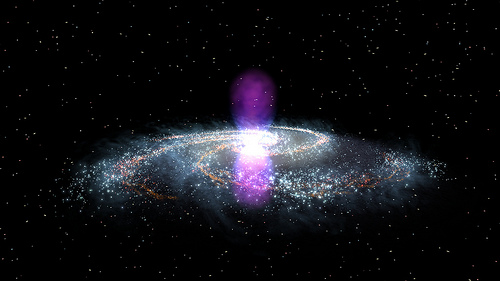
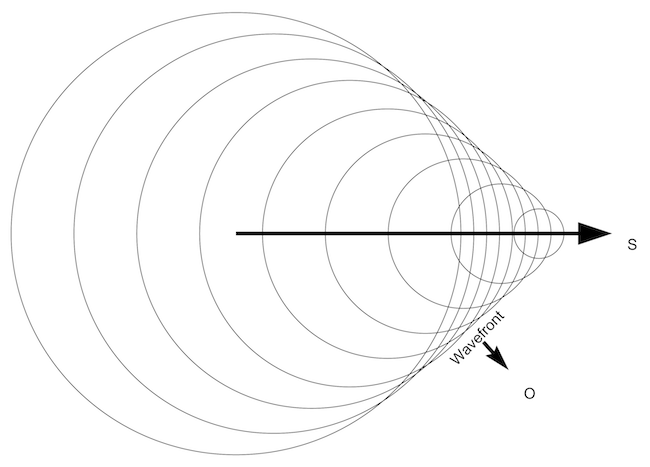
 rays in the sky, lasting from a few milliseconds to several minutes, and are currently believed to emanate from cataclysmic stellar collapses. The short flashes (the prompt emissions) are followed by an afterglow of progressively softer energies. Thus, the initial
rays in the sky, lasting from a few milliseconds to several minutes, and are currently believed to emanate from cataclysmic stellar collapses. The short flashes (the prompt emissions) are followed by an afterglow of progressively softer energies. Thus, the initial  —
— ergs in a few seconds. This energy output is similar to about 1000 times the total energy released by the sun over its entire lifetime.
ergs in a few seconds. This energy output is similar to about 1000 times the total energy released by the sun over its entire lifetime. —
— per day. Because of this inverse relationship between the rate and the estimated energy output, the total energy released per observed GRB remains the same.
per day. Because of this inverse relationship between the rate and the estimated energy output, the total energy released per observed GRB remains the same.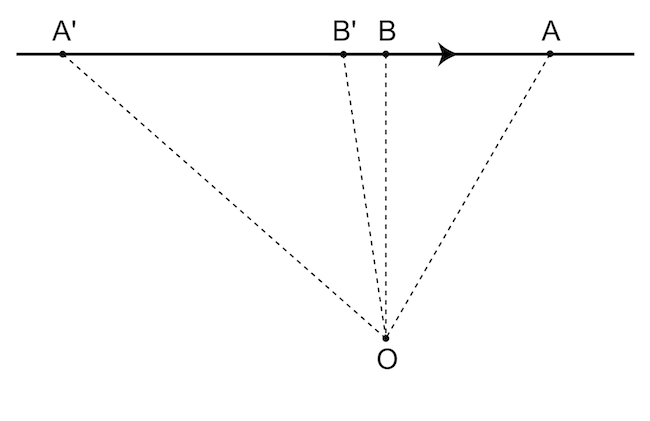
 to
to  through
through  and
and  at a constant supersonic speed. Imagine that the object emits sound during its travel. The sound emitted at the point
at a constant supersonic speed. Imagine that the object emits sound during its travel. The sound emitted at the point  before the sound emitted earlier at
before the sound emitted earlier at 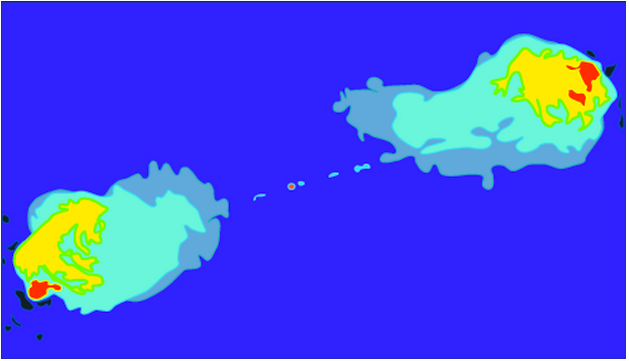

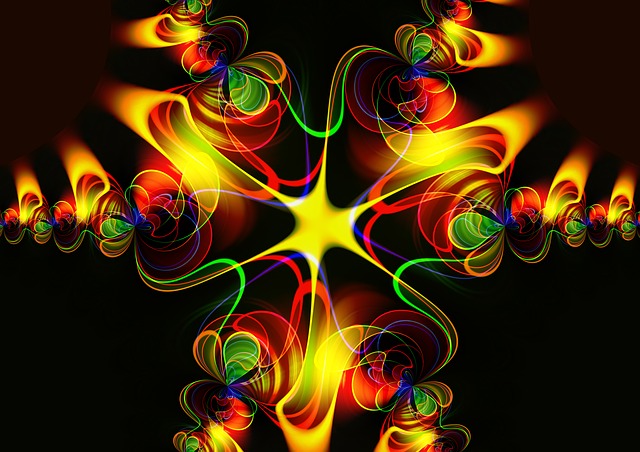



 .) It says something seemingly straightforward — you can measure two complimentary properties of a system only to a certain precision. For instance, if you try to figure out where an electron is (measure its position, that is) more and more precisely, its speed becomes progressively more uncertain (or, the momentum measurement becomes imprecise).
.) It says something seemingly straightforward — you can measure two complimentary properties of a system only to a certain precision. For instance, if you try to figure out where an electron is (measure its position, that is) more and more precisely, its speed becomes progressively more uncertain (or, the momentum measurement becomes imprecise). to observe the particle. The precision in the position we can hope to achieve is of the order of
to observe the particle. The precision in the position we can hope to achieve is of the order of  . In quantum mechanics, the momentum of each photon in the light beam is inversely proportional to the wavelength. At least one photon is reflected by the particle so that we can see it. So, by the classical conservation law, the momentum of the particle has to change by at least
. In quantum mechanics, the momentum of each photon in the light beam is inversely proportional to the wavelength. At least one photon is reflected by the particle so that we can see it. So, by the classical conservation law, the momentum of the particle has to change by at least  constant
constant constant.
constant. , where
, where  is the numerical aperture, which has a maximum value of one. Thus, the best spatial resolution is
is the numerical aperture, which has a maximum value of one. Thus, the best spatial resolution is  . Each photon in the light beam has a momentum
. Each photon in the light beam has a momentum  , which is the uncertainty in the particle momentum. So we get
, which is the uncertainty in the particle momentum. So we get  , approximately an order of magnitude bigger than the quantum mechanical limit. Through more rigorous statistical arguments, related to the spatial resolution and the expected momentum transferred, it may possible to derive the Heisenberg uncertainty principle through this line of reasoning.
, approximately an order of magnitude bigger than the quantum mechanical limit. Through more rigorous statistical arguments, related to the spatial resolution and the expected momentum transferred, it may possible to derive the Heisenberg uncertainty principle through this line of reasoning.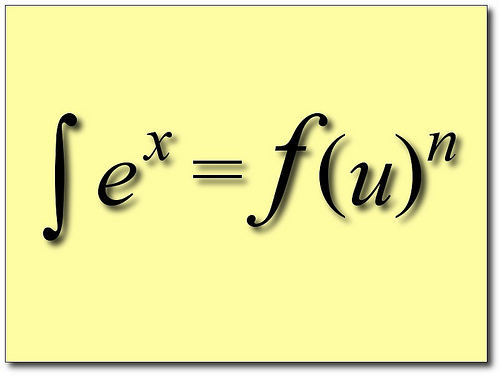
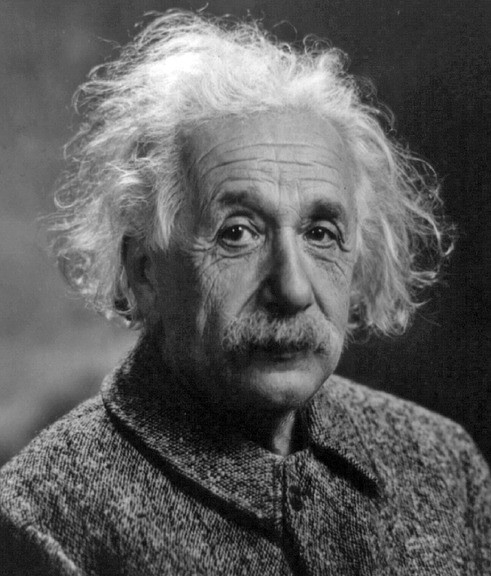


![[casual picture]](/img/kandm1-ss.jpg) Just before 1970, they (and me, which makes it we I guess) moved to Trivandrum, the capital city of Kerala. I lived in Trivandrum till I was 17. Lots of things happened in those years, but since this post is still (and always will be) work in progress, I can’t tell you all about it now.
Just before 1970, they (and me, which makes it we I guess) moved to Trivandrum, the capital city of Kerala. I lived in Trivandrum till I was 17. Lots of things happened in those years, but since this post is still (and always will be) work in progress, I can’t tell you all about it now.![[Wedding picture]](/img/kandm2-ss.jpg)
![[Anita Smiles]](/img/anita1-s.jpg)
![[Neil Smiles more!]](/img/neil-s.jpg)
![[Dad]](/img/dad.jpg) Later on, in 2007, I moved to
Later on, in 2007, I moved to